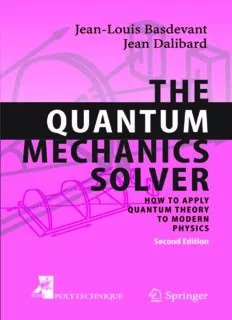
The quantum mechanics solver: how to apply quantum theory to modern physics PDF
Preview The quantum mechanics solver: how to apply quantum theory to modern physics
TThhiiss ppaaggee iinntteennttiioonnaallllyy lleefftt bbllaannkk Jean-Louis Basdevant Jean Dalibard The Quantum Mechanics Solver How to Apply Quantum Theory to Modern Physics SecondEdition With59Figures,Numerous Problems andSolutions ABC ProfessorJean-LouisBasdevant ProfessorJeanDalibard DepartmentofPhysics EcoleNormaleSuperieure LaboratoireLeprince-Ringuet LaboratoireKastlerBrossel EcolePolytechnique rueLhomond24,75231 91128PalaisseauCedex Paris,CX05 France France E-mail:jean-louis.basdevant@ E-mail:[email protected] polytechnique.edu LibraryofCongressControlNumber:2005930228 ISBN-10 3-540-27721-8(2ndEdition)SpringerBerlinHeidelbergNewYork ISBN-13 978-3-540-27721-7(2ndEdition)SpringerBerlinHeidelbergNewYork ISBN-10 3-540-63409-6(1stEdition)SpringerBerlinHeidelbergNewYork ISBN-13 978-3-540-63409-6(1stEdition)SpringerBerlinHeidelbergNewYork Thisworkissubjecttocopyright.Allrightsarereserved,whetherthewholeorpartofthematerialis concerned,specificallytherightsoftranslation,reprinting,reuseofillustrations,recitation,broadcasting, reproductiononmicrofilmorinanyotherway,andstorageindatabanks.Duplicationofthispublication orpartsthereofispermittedonlyundertheprovisionsoftheGermanCopyrightLawofSeptember9, 1965,initscurrentversion,andpermissionforusemustalwaysbeobtainedfromSpringer.Violationsare liableforprosecutionundertheGermanCopyrightLaw. SpringerisapartofSpringerScience+BusinessMedia springeronline.com (cid:1)c Springer-VerlagBerlinHeidelberg2006 PrintedinTheNetherlands Theuseofgeneraldescriptivenames,registerednames,trademarks,etc.inthispublicationdoesnotimply, evenintheabsenceofaspecificstatement,thatsuchnamesareexemptfromtherelevantprotectivelaws andregulationsandthereforefreeforgeneraluse. Typesetting:bytheauthorsandTechBooksusingaSpringerLATEXmacropackage Coverdesign:design&productionGmbH,Heidelberg Printedonacid-freepaper SPIN:11430261 56/TechBooks 543210 TThhiiss ppaaggee iinntteennttiioonnaallllyy lleefftt bbllaannkk Preface to the Second Edition Quantum mechanics is an endless source of new questions and fascinating observations. Examples can be found in fundamental physics and in applied physics,inmathematicalquestionsaswellasinthecurrentlypopulardebates ontheinterpretationofquantummechanicsanditsphilosophicalimplications. Teaching quantum mechanics relies mostly on theoretical courses, which are illustrated by simple exercises often of a mathematical character. Reduc- ing quantum physics to this type of problem is somewhat frustrating since very few, if any, experimental quantities are available to compare the results with.Foralongtime,however,fromthe1950stothe1970s,theonlyalterna- tive to these basic exercises seemed to be restricted to questions originating fromatomicandnuclearphysics,whichweretransformedintoexactlysoluble problems and related to known higher transcendental functions. In the past ten or twenty years, things have changed radically. The devel- opment of high technologies is a good example. The one-dimensional square- well potential used to be a rather academic exercise for beginners. The emer- gence of quantum dots and quantum wells in semiconductor technologies has changedthingsradically.Optronicsandtheassociateddevelopmentsininfra- redsemiconductorandlasertechnologieshaveconsiderablyelevatedthesocial rank of the square-well model. As a consequence, more and more emphasis is given to the physical aspects of the phenomena rather than to analytical or computational considerations. Many fundamental questions raised since the very beginnings of quantum theory have received experimental answers in recent years. A good example istheneutroninterferenceexperimentsofthe1980s,whichgaveexperimental answers to 50 year old questions related to the measurability of the phase of the wave function. Perhaps the most fundamental example is the experimen- tal proof of the violation of Bell’s inequality, and the properties of entangled states, which have been established in decisive experiments since the late 1970s. More recently, the experiments carried out to quantitatively verify de- coherence effects and “Schr¨odinger-cat” situations have raised considerable VI Preface to the Second Edition interest with respect to the foundations and the interpretation of quantum mechanics. This book consists of a series of problems concerning present-day experi- mental or theoretical questions on quantum mechanics. All of these problems are based on actual physical examples, even if sometimes the mathematical structureofthemodelsunderconsiderationissimplifiedintentionallyinorder to get hold of the physics more rapidly. The problems have all been given to our students in the E´cole Polytech- niqueandintheE´coleNormaleSup´erieureinthepast15yearsorso.Aspecial featureoftheE´colePolytechniquecomesfromatraditionwhichhasbeenkept for more than two centuries, and which explains why it is necessary to devise originalproblemseachyear.Theexamshaveadoublepurpose.Ononehand, they are a means to test the knowledge and ability of the students. On the other hand, however, they are also taken into account as part of the entrance examinations to public office jobs in engineering, administrative and military careers. Therefore, the traditional character of stiff competitive examinations andstrictmeritocracyforbidsustomakeuseofproblemswhichcanbefound intheexistingliterature.Wemustthereforeseekthemamongtheforefrontof present research. This work, which we have done in collaboration with many colleagues, turned out to be an amazing source of discussions between us. We all actually learned very many things, by putting together our knowledge in our respective fields of interest. Compared to the first version of this book, which was published by Springer-Verlag in 2000, we have made several modifications. First of all, we have included new themes, such as the progress in measuring neutrino oscillations, quantum boxes, the quantum thermometer etc. Secondly, it has appearedusefultoinclude,atthebeginning,abriefsummaryonthebasicsof quantum mechanics and the formalism we use. Finally, we have grouped the problems under three main themes. The first (Part A) deals with Elementary Particles, Nuclei and Atoms, the second (Part B) with Quantum Entangle- ment and Measurement, and the third (Part C) with Complex Systems. We are indebted to many colleagues who either gave us driving ideas, or wrote first drafts of some of the problems presented here. We want to pay a tribute to the memory of Gilbert Grynberg, who wrote the first versions of “The hydrogen atom in crossed fields”, “Hidden variables and Bell’s inequal- ities” and “Spectroscopic measurement on a neutron beam”. We are particu- larlygratefultoFranc¸oisJacquet,Andr´eRoug´eandJimRichforilluminating discussions on “Neutrino oscillations”. Finally we thank Philippe Grangier, whoactuallyconceivedmanyproblemsamongwhichthe“Schro¨dinger’scat”, the “Ideal quantum measurement” and the “Quantum thermometer”, G´erald Bastard for “Quantum boxes”, Jean-No¨el Chazalviel for “Hyperfine struc- ture in electron spin resonance”, Thierry Jolicoeur for “Magnetic excitons”, Bernard Equer for “Probing matter with positive muons”, Vincent Gillet for “Energylossofionsinmatter”,andYvanCastin,Jean-MichelCourtyandDo- Preface to the Second Edition VII minique Delande for “Quantum reflection of atoms on a surface” and “Quan- tum motion in a periodic potential”. Palaiseau, April 2005 Jean-Louis Basdevant Jean Dalibard TThhiiss ppaaggee iinntteennttiioonnaallllyy lleefftt bbllaannkk Contents Summary of Quantum Mechanics .............. .............. 1 1 Principles .............................................. 1 2 General Results ......................................... 4 3 The Particular Case of a Point-Like Particle; Wave Mechanics. 4 4 Angular Momentum and Spin............................. 6 5 Exactly Soluble Problems ................................ 7 6 Approximation Methods.................................. 9 7 Identical Particles ....................................... 10 8 Time-Evolution of Systems ............................... 11 9 Collision Processes....................................... 12 Part I Elementary Particles, Nuclei and Atoms 1 Neutrino Oscillations ...................................... 17 1.1 Mechanism of the Oscillations; Reactor Neutrinos ........... 18 1.2 Oscillations of Three Species; Atmospheric Neutrinos ........ 20 1.3 Solutions ............................................... 23 1.4 Comments.............................................. 27 2 Atomic Clocks............................................. 29 2.1 The Hyperfine Splitting of the Ground State................ 29 2.2 The Atomic Fountain .................................... 31 2.3 The GPS System ........................................ 32 2.4 The Drift of Fundamental Constants....................... 32 2.5 Solutions ............................................... 33 3 Neutron Interferometry ................................... 37 3.1 Neutron Interferences .................................... 38 3.2 The Gravitational Effect ................................. 39 3.3 Rotating a Spin 1/2 by 360 Degrees........................ 40
Description: